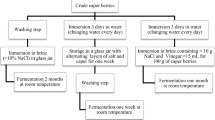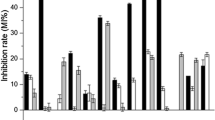Abstract
Culture-based technique was used to study the population dynamics of the bacteria and determine the dominant lactic acid bacteria (LAB) during cassava fermentation. LAB was consistently isolated from the fermented mash with an initial viable count of 6.00 log c.f.u. g−1 observed at 12 h. The aerobic viable count of amylolytic lactic acid bacteria (ALAB) was higher than other group of LAB throughout the fermentation up to 96 h with the highest viable count of 8.08 log c.f.u. g−1. Combination of phenotypic parameters and 16S rDNA gene sequencing identified the dominant group of LAB as Lactobacillus plantarum, L. fermentum and Leuconostoc mesenteroides while the pulse field gel electrophoresis determined that the strains were genotypically heterogeneous. The sugar fermentation profile of the isolates showed that indigestible sugars such as raffinose and stachyose can be fermented by the strains. Information was also generated about the functional properties of the strains. Only strain L. plantarum 9st0 isolate at 0 h of the fermentation produced bacteriocin with antagonism against closely related indicator strains. Quantitatively, the highest amylase activity was produced by strain L. plantarum 7st12, while appreciable amylase was also produced by L. fermentum 1st96. The result of this work showed that selection of mixed starter cultures of bacteriocin- and amylase-producing L. plantarum and L. fermentum will be highly relevant as starter cultures during the intermediate and large scale gari production.




Similar content being viewed by others
References
Acedo-Felix E, Perez-Martinez G (2003) Significant differences between Lactobacillus casei subsp. Casei ATCC 393T and a commonly used plasmid-cured derivative revealed by a polyphasic study. Int J Syst Evol Microbiol 53:67–75
Agati V, Guyot JP, Morlon-Guyot J, Talamond P, Hounhouigan DJ (1998) Isolation and characterization of new amylolytic strains of Lactobacillus fermentum from fermented maize doughs (mawe and ogi) from Benin. J Appl Microbiol 85:512–520
Ampe F, Ben Omar N, Moizan C, Wacher C, Guyot JP (1999) Polyphasic study of the spatial distribution of microorganisms in Mexican pozol, a fermented maize dough, demonstrates the need for cultivation-independent methods to investigate traditional fermentations. Appl Environ Microbiol 65:5464–5473
Ben Omar N, Ampe F (2000) Microbial community dynamics during production of the Mexican fermented maize dough pozol. Appl Environ Microbiol 66:3664–3673
Bernefeld P (1955) Amylase β and α. Methods Enzymol 1:149–158
Brauman A, Keleke S, Malonga M, Miambi E, Ampe F (1996) Microbiological and biochemical characterization of cassava retting a traditional lactic acid fermentation for foo-foo (Cassava flour) production. Appl Environ Microbiol 62:2854–2858
Coulin P, Farah Z, Assavo J, Spillmann H, Puhan Z (2006) Characterization of the microflora of attieke, a fermented cassava product, during traditional small-scale preparation. Int J Food Microbiol 106:131–136
Ercolini D, Moschetti G, Blaiotta G, Coppola S (2001) The potential of a polyphasic PCR-DGGE approach in evaluating microbial diversity of natural whey cultures for water-buffalo Mozzarella cheese production: bias of culture dependent and culture independent approaches. Syst Appl Microbiol 24:610–617
Giraud E, Brauman A, Keleke S, Lelong B, Raimbault M (1991) Isolation and physiological study of an amylolytic strain of Lactobacillus plantarum. Appl Microbiol Biotechnol 36:379–383
Herrero M, Mayo B, Gonzalez B, Suarez JE (1996) Evaluation of technologically important traits in lactic acid bacteria isolated from spontaneous fermentations. J Appl Microbiol 81:565–570
Holzapfel WH (2002) Appropriate starter cultures technologies for small scale fermentation in developing countries. Int J Food Microbiol 76:197–212
Kostinek M, Specht I, Edward VA, Schillinger U, Hertel C, Holzapfel WH, Franz CM (2005) Diversity and technological properties of predominant lactic acid bacteria from fermented cassava used for the preparation of gari, a traditional African food. Syst Appl Microbiol 6:527–540
Lindgren S, Refai O (1984) Amylolytic lactic acid bacteria in fish silage. J Appl Bacteriol 57:221–228
Morlon-Guyot JP, Guyot JP, Pot B, Jacobe de Haut I, Raimbault M (1998) Lactobacillus manihotivorans sp. Nov., a new starch-hydrolyzing lactic acid bacterium isolated from cassava sour starch fermentation. Int J Syst Bacteriol 48:1101–1109
Obilie EM, Tano-Debrak K, Amoa-Awua WK (2004) Souring and breakdown of cyanogenic glucoside during the processing of cassava into akyeke. Int J Food Microbiol 93:115–121
Odunfa SA (1985) African fermented foods. In: Wood BJB (ed.) Microbiology of fermented foods, vol 2. Elsevier Applied Science Publisher, London, pp 155–191
Oguntoyinbo FA, Sanni AI, Franz CMAP, Holzapfel WH (2007) In vitro selection and evaluation of Bacillus starter cultures for the production of okpehe, a traditional African fermented condiment. Int J Food Microbiol 113:208–218
Ojo O, Deane R (2002) Effects of cassava processing methods on antinutritional components and health status of children. J Sci Food Agric 82:252–257
Okafor N (1977) Microorganisms associated with cassava fermentation for gari production. J Appl Bacteriol 42:279–284
Olasupo NA, Olukoya DK, Odunfa SA (1996) Studies of some local strains of amylolytic Lactobacillus from Nigerian fermented foods. Nahrung 40:44–46
Olympia M, Fukuda H, Ono H, Kaneko Y, Takano M (1995) Characterization of starch-hydrolysing lactic acid bacteria isolated from fermented fish and rice food, Burong Isda and its amylolytic enzyme. J Ferment Bioeng 80:124–130
Oyewole OB (1992) Cassava processing in Africa. Application of biotechnology to traditional fermented foods. National Research Council. National Academy Press, Washington, pp 89–92
Pitcher DG, Saunders NA, Owen RJ (1989) Rapid extraction of bacterial genomic DNA with the guanidium thiocyanate. Lett Appl Microbiol 8:151–156
Sanni AI (1993) The need for process optimization of African fermented foods and beverages. Int J Food Microbiol 18:85–95
Sanni AI, Morlon-Guyot J, Guyot JP (2002) New efficient amylase-producing strains of Lactobacillus plantarum and L. fermentum isolated from different Nigerian traditional fermented foods. Int J Food Microbiol 72:53–62
Schleifer KH, Ludwig W (1995) Phylogenetic relationships of lactic acid bacteria. In: Wood BJB, Holzapfel WH (eds) The genera of lactic acid bacteria. The lactic acid bacteria, vol 2. Chapman and Hall, Glasgow, pp 7–17
Schillinger U, Lucke FK (1989) Antibacterial activity of the Lactobacillus sake isolated from meat. Appl Microbiol Biotechnol 55:1901–1906
Schillinger U, Stiles ME, Holzapfel WH (1993) Bacteriocin production by Canobacterium priscicola LV61. Int J Food Microbiol 20:131–147
Xiaodong W, Xuan G, Rakshit SK (1997) Direct fermentative production of lactic acid from cassava and other starch substrates. Biotechnol Lett 9:841–843
Acknowledgement
Numerous supports of Korede James Oni during sampling and preparation of the manuscript are gratefully acknowledged.
Author information
Authors and Affiliations
Corresponding author
Rights and permissions
About this article
Cite this article
Oguntoyinbo, F.A. Identification and functional properties of dominant lactic acid bacteria isolated at different stages of solid state fermentation of cassava during traditional gari production. World J Microbiol Biotechnol 23, 1425–1432 (2007). https://doi.org/10.1007/s11274-007-9386-7
Received:
Accepted:
Published:
Issue Date:
DOI: https://doi.org/10.1007/s11274-007-9386-7




